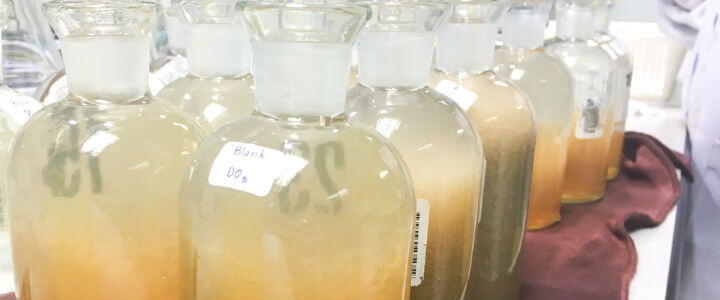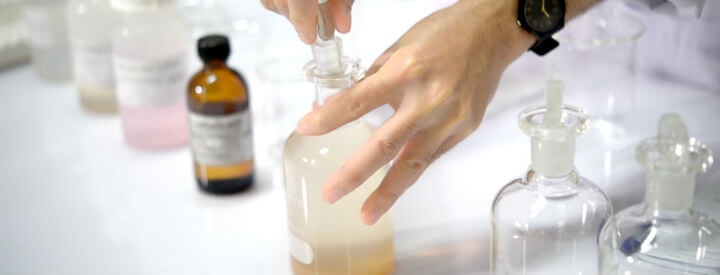Biochemical Oxygen Demand (BOD) in Wastewater Treatment
Written by AOS Treatment Solutions on October 30, 2018

Water is one of nature’s most precious resources. Groundwater is essential in sustaining plant and animal life and as a raw material for many industries. Wastewater is water that has been contaminated from human activity, environmental, or industrial processes and must be treated for reuse or safe disposal.
Usually determined alongside chemical oxygen demand (COD) in wastewater treatment, BOD is an important index that every industrial and municipal authority in the country should be aware of.
What Is Biological Oxygen Demand in Wastewater Treatment?
Biochemical oxygen demand or biological oxygen demand (BOD) is a measure of the amount of Dissolved Oxygen (DO) required by aerobic microorganisms to decompose organic matter present in a sample of water at a certain temperature over a studied period. BOD value is usually expressed in milligrams of oxygen per liter of water (mg/L).
What Is Dissolved Oxygen?
Dissolved Oxygen is the amount of gaseous oxygen dissolved in a sample of water. O2 can be absorbed directly from the atmosphere or indirectly from the by-product of photosynthesis in surrounding plants.
The Significance of Biological Oxygen Demand
Both aquatic life and microorganisms require oxygen to survive. Microbes utilize dissolved O2 in water to break down complex organic compounds present in the water such as sugars, cellulose, and other convertible synthetic substances. Marine animals such as fish use dissolved oxygen for respiration.
However, the balance of DO consumption is quite delicate. When a large number of organic compounds are present in water, microbial activity will proliferate, putting a strain on the aquatic ecosystem. Critical DO reduction will ultimately harm marine life.
The Significance of BOD in Wastewater Treatment

Regulations concerning permissible BOD levels for wastewater disposal in industries and municipalities vary from state to state. BOD is listed as a conventional pollutant under the U.S. Clean Water Act. Typical maximum values range from 10 mg/L for direct environmental disposal and 300 mg/L for disposal to sewer systems.
Knowing BOD value helps municipal authorities determine their biological water quality and industries to assess the impact effluent disposal will have on the immediate environment.
Applications of Biological Oxygen Demand in Wastewater Treatment
Wastewater treatment plants use BOD value as an index to ascertain the overall degree of organic pollution in a water source. A BOD test is typically carried out over a standard 5-day incubation period at 20°C (68°F) for the most accurate results.
Generally, a higher BOD value indicates a higher level of water pollution, while a lower BOD value indicates less polluted, or cleaner water.
Benefits of BOD Removal Wastewater Treatment
Municipalities can use a BOD test to detect water contamination in their public supply to ensure that it is safe for human consumption. Industries need to know their BOD value to determine when treated wastewater is safe for reuse or disposal.
How to Reduce BOD in Industrial Wastewater
Several techniques are used for BOD removal in wastewater prior to reuse or safe disposal. Three common BOD reduction methods for wastewater treatment are:
- Wastewater clarification
- Wastewater separation (Coagulation & Flocculation)
- Anaerobic microbial decomposition
Wastewater clarification and separation BOD reduction methods are part of the primary phase of wastewater treatment while anaerobic microbial decomposition is part of the second phase of treatment.
Wastewater Clarification

Wastewater clarification removes organic solids (primary sludge) from the water by utilizing the force of gravity – in other words, the heavier particles settle to the bottom and are removed first. Wastewater clarification is often followed by a chemical separation process.
Wastewater Separation (Coagulation and Flocculation)
Wastewater separation removes any colloidal solids suspended in wastewater by coagulation and flocculation.
In coagulation, a non-toxic agglomerating agent such as Ferric Chloride (FeCl) or alum is added to the wastewater causing the suspended particles to come together to form clumps which can easily be removed from the water by filtration.
Flocculation uses a chemical polymer (flocculating agent) to precipitate organic particles out of the water by coalescing to form larger particles or flocs. These larger particles can then be deposited into a sedimentation tank for further treatment prior to disposal.
Removal of organic matter from wastewater using coagulants and flocculants eliminates the ‘food’ necessary for microbes to thrive, thus reducing the competition for dissolved oxygen with marine life.
Anaerobic Microbial Decomposition
Anaerobic microbial decomposition introduces microorganisms or bacteria cultures into wastewater in the absence of air to break down the organic particles present. The product of an anaerobic digestion process is the generation of biogas.
Anaerobic decomposition is a highly beneficial method because the biofuel generated from the process can be utilized as an alternative energy source for power, heating, and drying applications.
Wastewater Treatment Services with AOS
Municipalities and industrial clients that need to carry out a BOD test, COD removal from wastewater, or determine the best wastewater management plan for their needs can contact the AOS municipal water treatment experts for a range of municipal wastewater treatment services.
Serving the industry since 1999, AOS Treatment Solutions provides a robust range of wastewater treatment solutions including water clarification, sludge dewatering, chlorination/de-chlorination, phosphorus removal, and odor control.
AOS combines cutting-edge technology with decades of expertise to address the most challenging water treatment needs for a diverse range of clients including private businesses, corporations, and local government agencies.
For more information on our services, call (936) 539-0040 or contact us online today for help with your wastewater treatment needs!

